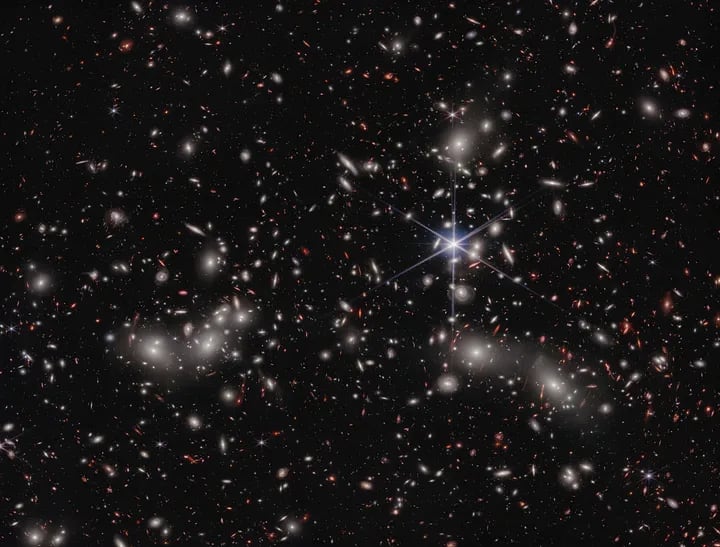Released by NASA
Stunning new imagery of a star nursery

The James Webb Space Telescope (JWST), the most potent space-based astronomical observatory ever deployed, celebrated its first anniversary on Wednesday.
It has already given innumerable insights into the natural world over the last year, from inside the Solar System to the distant reaches of the Universe. It is jointly managed by NASA, the Canadian Space Agency (CSA), and the European Space Agency (ESA).
New information on the star-forming area Rho Ophiuchi was made public to commemorate the first anniversary of JWST. One of the most researched, it is also the closest such cloud complex to Earth, located only 3.7 million billion kilometers (2.3 million billion miles) away, according to the most current calculations.
The view from the telescope reveals roughly 50 extremely young stars, all of which are about the mass of the Sun and are just a million years old or younger (compared to our Sun's age of 4.6 billion years).

— — — — — — Click To Get Access To PaidOnlineWriting jobs!! — — — —
Many of the objects that were observed are T Tauri stars, which glow instead as a consequence of the gravitational contraction of a star that is continuously contracting rather than as a result of nuclear fusion in their cores. They will begin their lives as main sequence stars, the stable mature form in which the star will spend the majority of its existence, after shrinking sufficiently to increase temperature in their core to the level where nuclear fusion from hydrogen to helium will occur. This process takes roughly 100 million years.
Even the specialist equipment of JWST cannot capture light produced from inside the vast dust clouds that make up the dark zones. The massive red streams, also known as Dark River clouds or Rho Ophiuchi Streamers, are made of molecular hydrogen and are frequently created when a young star finally produces enough radiation to eject its natal dust cocoon and shoot out jets of material into deep space.
There are also indications of protoplanetary disks, or possible future planetary systems, in several of the image's stars.
When the telescope was completely operational last year, a consortium of NASA, ESA, and CSA experts stated that "almost across the board, the science performance of JWST is better than expected." The newest image from JWST confirms this statement.
JWST data has provided confirmation that the protoplanetary disk surrounding the star d203–506 in the Orion Nebula contains the chemical methyl cation (CH3+).
Although CH3+ was previously hypothesized to have a role in interstellar chemistry in the 1970s, it wasn't until the MIRI and NIRCam instruments of the observatory that it was first discovered. At the end of June, the preliminary findings were announced.

— — — — Click To Get Access To Lifechanging Marketing Secrets — — — —
All known life is based on carbon compounds, which are carefully studied for this reason. CH3+ is particularly significant because it reacts with a wide variety of other molecules but not with hydrogen, which makes up the majority of the visible universe. This suggests that CH3+ may act as a catalyst for the emergence of other molecules and more complex structures, such as amino acids and proteins, and ultimately the emergence of organic life.
The investigation of CH3+ also sheds insights on the paradoxical role that UV light plays in the creation of planetary systems. Because portion of the UV spectrum of light is known to be extremely damaging when it interacts with organic molecules, excessive exposure to sunlight can result in sunburns and, in some circumstances, skin cancer. However, it is also recognized that ultraviolet radiation can wreak havoc on young planetary systems, including our own.
The latest study clarifies the paradoxical nature of UV light's damaging effects on organic molecules already in existence while simultaneously demonstrating its necessity for the formation of the precursors to those molecules.

Olivier Berné of the University of Toulouse in France, the study's principal investigator, explains, "This clearly illustrates that UV light may fundamentally modify the chemistry of a protoplanetary disc. By assisting in the production of CH3+, it may really play a crucial part in the early chemical steps of the genesis of life - a possibility that has maybe been previously underappreciated.
JWST has kept up its examination of far-off galaxy clusters. Abell 2744, also known as Pandora's cluster, was seen by the telescope in February during the course of 30 hours of observation with the NIRCam instrument. The cluster itself is composed of at least four different galaxy clusters that first collided some 350 million years ago. As a result, a variety of strange phenomena have been created that scientists are still attempting to understand.

— — — — — — Click To Get Access To PaidOnlineWriting jobs!! — — — —
Thank you for reading my article! I appreciate you taking the time to read my work and I hope you found it informative and helpful.
If you enjoyed the article, please share it with your friends and followers on social media. You can also follow me on Medium to stay up-to-date on my latest articles.
“I’m always happy to hear feedback from my readers. If you have any thoughts on this article, please leave a comment below”
About the Creator
Eview Nicks
With my renowned reputation as an avid reader, I delight in sharing profound literary encounters. Join me as I unveil the allure of captivating books and craft compelling articles on distinctive aspects. Discover a world of reading.






Comments
There are no comments for this story
Be the first to respond and start the conversation.